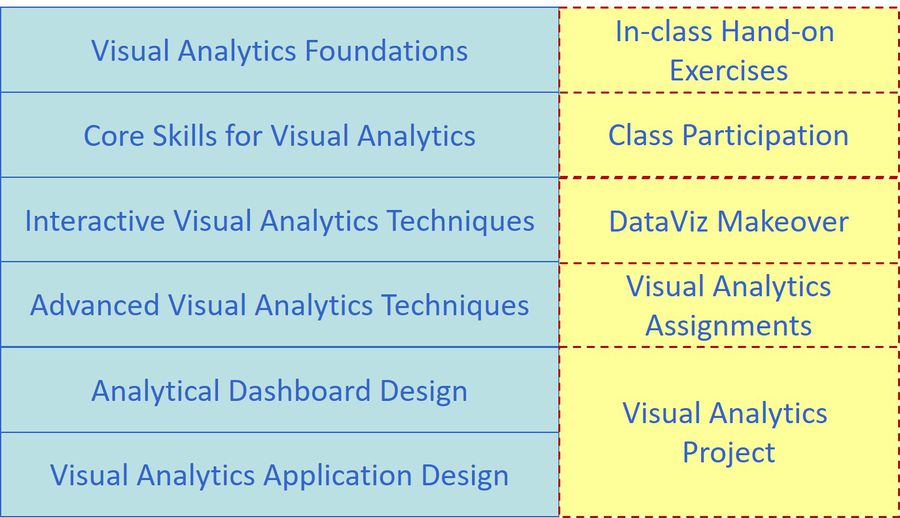Course information
|
|
|
|
|
|
Contents
Synopsis
In this competitive global environment, the ability to explore visual representation of business data interactively and to detect meaningful patterns, trends and exceptions from these data are increasingly becoming an important skill for data analysts and business practitioners. Drawing from research and practice on Data Visualisation, Human-Computer Interaction, Data Analytics, Data Mining and Usability Engineering, this course aims to share with you how visual analytics techniques can be used to interact with data from various sources and formats, explore relationship, detect the expected and discover the unexpected without having to deal with complex statistical formulas and programming.
The goals of this course are:
- To share with you the principles, best practices and methods of visual analytics
- To provide you hands-on experiences in using commercial-off-the-shelf visual analytics software and programming tools to design visual analytics applications
Learning Objectives
Upon successful completion of the course, students will be able to:
- Understand the basic concepts, theories and methodologies of visual analytics.
- Analyse data using appropriate visual thinking and visual analytics techniques.
- Present data using appropriate visual communication and graphical methods.
- Design and implement cutting-edge visual analytics system for supporting decision making.
Basic Modules
This course comprises ten integrated components as shown below:
Course Assessment
The assessment of this course consists of four major components, namely:
- class participation,
- in-class hands-on exercise,
- DataViz makeover
- individual assignments,
- visual analytics project.
There will be no mid-term test or final examination for this course.
Class Participation
A strict requirement for each class meeting is to complete the assigned readings and to try out the hands-on exercises before coming to class. Readings will be provided from the textbook on technical information and from provided documents and articles on business applications of Visual Analytics. Students are required to review the recommended readings and class exercises before coming to class. Without preparation, the learning and discussions would not be as meaningful. Student sharing of insights from readings and hands-on exercises of assigned materials in class participation will form a large part of the learning in this course.
DataViz Makeover
Each week, I will post one or two data visualisation and you are required to critic, suggest ways for improvement and rework the data visualisation. Maybe you retell the story more effectively, or find a new story in the data. I am curious to see the different approaches you all take.
The purpose of the makeover is to improve on the original visualisation. Focus on what works, what doesn’t work, why those things don’t work, and how you made it better. You should try stick to the fields in the data set provided and improve upon the original visualisation. However, if supplementing the data helps you tell a better story, go for it!
You are required to upload the weekly makeover onto the dropbox of e-Learn (i.e. LMS) by Thursday before mid-night 11.59pm.
Individual Assignments
There is one assignment that is due throughout the term. Assignment due is to be uploaded into the course wiki strictly before the official due dates. Late work will be severely penalised. Students must check and confirm on Wiki the assignment due dates.
The assignment will be graded on a scale from 0 to 100. Scores of 70 and 80 are given when the assignment is essentially done completely and correctly. Scores 90 and 100 are reserved for complete and correct homework where extra initiative or innovation clearly sets the completed work above the simple, perfunctory and satisfactory completion of the mini-assignment.
Visual Analytics Project
The purpose of the project is to provide students first hand experience on collecting, processing and analysing large business data using real world data. A project may involve developing new methods or implementing visual analytics system to support analytic tasks in specific domains. Alternatively, a project may be in the form of application development by integrating analytical tools within a visual analytics environment. Students are encouraged to focus on research topics that are relevant to their field of study. It should address a concrete visual analytics problem and should propose a novel and creative solution.
For more details please refer to Visual Analytics Project page
Grading Summary
The grading distribution of this course is as follows:
- Class Participation 10%
- DataViz Makeover 20%
- Assignment 25%
- Visual Analytics Project 45%
- Wiki 15%
- Poster 15%
- Workshop 20%
- Practice research paper 25%
- Artifact 25%
There will be no mid-term test or final examination for this course.

